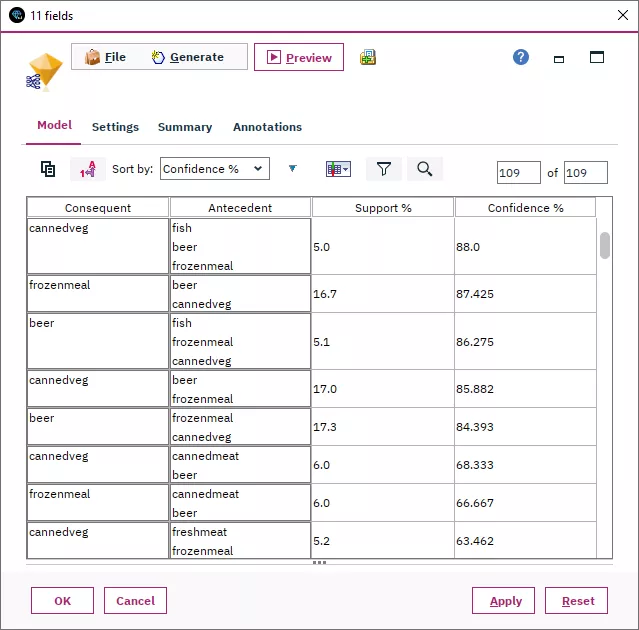Basket analysis identifies associations between different products or services, selected simultaneously. Association rule algorithms, such as the Apriori algorithm or CARMA, are key tools used to detect these patterns.
What is basket analysis?
Basket analysis is a method that uncovers hidden relationships between products based on their co-occurrence in transactions. A key element of this technique are association rules, which define the patterns that occur between products in different baskets. These rules aim to identify the probability with which the purchase of one product may lead to the purchase of another.
Association rules and their characteristics
Association rules consist of two parts: a predecessor (one or more) and a successor (one in the Apriori algorithm or many in the CARMA algorithm). Predecessors are elements that appear before the occurrence of another element in the rule. A successor is an element that appears after certain conditions have been met, i.e. after the predecessors have occurred in the rule.
For example, we might learn from the data that if a customer buys bread, there is a probability that they will also buy butter. Rules may also contain more elements, e.g. if both bread and butter are already in the basket, there is a good chance that milk will also be purchased.
Basket analysis, based on historical data and analysis of the frequency of occurrence of different elements, allows this kind of relationship to be discovered. Rules are defined by two main indicators:
- Coverage - how often a rule appears in the dataset, expressed as a percentage of the number of occurrences of a given predecessor.
- Confidence - defines how confidently the purchase of one product leads to the purchase of another.
Other indicators by which we can determine the usefulness of individual rules are growth and implementability. Growth measures the strength of the association between products, showing how many times more likely they are to occur together compared to if they were independent of each other. High growth indicates a strong relationship between the products, making the rule more valuable for marketing strategies.
Implementability is a measure of what percentage of learning data meets the predecessor but does not meet the successor. In the context of product purchase, this means what percentage of all customers have (or have bought) the predecessor but have not yet bought the successor. This is particularly important for sales strategies as it identifies a group of customers who can be offered additional products based on their previous purchases.

Fig. 1
Result of the basket analysis model - according to the first rule, if the customer has fish, beer and frozen dishes in the basket, he will also buy canned vegetables. Such items in the basket will be found in 5% of the transactions, and the chance of this rule working is 88%.
Use of basket analysis
Basket analysis is used in many areas of business. It is most commonly used in retailing, where it allows you to identify the products that customers buy together, enabling you to create more effective sales strategies.
With basket analysis, it is possible, for example, to detect that customers who buy milk often also choose breakfast cereals. Such discoveries can lead to changes in the way products are arranged in the shop, increasing the chances of additional purchases. In addition, companies can personalise promotional offers based on customers' previous purchases, thereby increasing customer loyalty and sales.
In e-commerce, basket analysis is made even more dynamic and effective by access to huge data sets. Identifying products that are frequently purchased together makes it possible to create attractive bundles or promotional sets. For example, if the analysis shows that customers often buy a mobile phone together with a case, the company can offer a special set at a favourable price.
The information obtained through association rules will also help to optimise the assortment - a better understanding of which products are often bought together allows for more efficient inventory management.
Association rules help to segment customers and target them with tailored marketing messages. By knowing which services are often bought together, you can create effective cross-selling and up-selling campaigns, thereby increasing sales.
Challenges of basket analysis
Despite its many benefits, basket analysis also presents some challenges. The main ones are:
- Large data sets - in order for the conclusions of the analysis to be meaningful, it must be carried out on a large data set, which requires the right tools and infrastructure.
- High variability of patterns - customer preferences can change depending on the season, trends or promotions, making basket analysis a must.
- Selection of relevant rules - the analysis process can produce a very large number of association rules. The key is to select the most valuable ones, based on indicators such as coverage, confidence, growth or implementability.
- Purchasing context - analysing purchasing data alone may not be sufficient. It is also important to consider the context of the purchase, which may influence the results (e.g. buying products for gifts, purchases made under the influence of promotions).
Above all, an appropriate analytical tool is required to perform effective basket analysis. Using PS CLEMENTINE PRO, the aforementioned Apriori and CARMA algorithms can be used for this.
Summary
Basket analysis is an important sales and assortment management support tool that enables businesses to better understand their customers' purchasing behaviour. The use of association rules allows the discovery of valuable patterns, which can then be used in marketing and sales strategies. With the right tools in place, companies can implement basket analysis effectively, maximising their benefits from their transactional data.
Central to this process is the understanding that basket analysis is a dynamic tool that requires ongoing updating and adaptation to changing customer preferences and market conditions. Properly implemented, it can be a vital part of the market success of any organisation selling products.